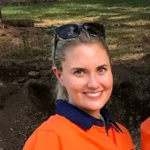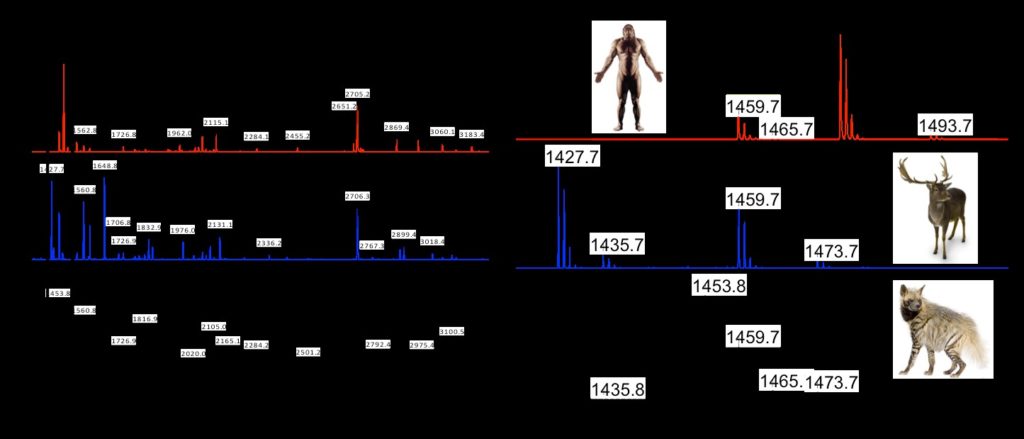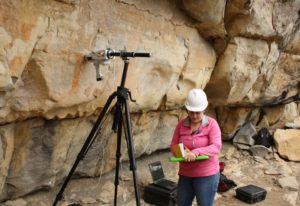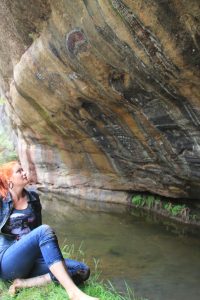A Griffith archaeological science student, testing new ways to identify where items in archaeological and museum collections have come from, has been awarded funding by the Australian Association of Consulting Archaeologists Inc (AACAI).
The funding opportunity comes as the University announces a new proof-of-concept Bachelor of Arts Honours stream catering for archaeology students with either professional or academic aspirations in the field.

Aimee Henderson on fieldwork)
Aimee Henderson said her project would involve a series of archival research and laboratory analyses, and the generous support from AACAI would help determine the provenance of collection items (like Aboriginal spears).
“I have chosen ZooMS (Zooarchaeology by Mass Spectrometry) and ancient DNA methods because we can work with very small samples, so you can’t see where the work has been done,” Aimee explained.

Image illustrates the use of ZooMS-spectra to identify animal species
“Taking a small piece of organic material, like bone or tooth, I am trying to identify which animal species was used to make the item and which geographic region it came from.
“Because these methods are relatively new and have rarely been used the way I am using them, I have also had to consider if the object in the collection has been treated and what its condition is.
“For example, if it was restored, what products were used and how will that influence my sampling and results?”
Henderson is leading one of just three projects to receive financial support from AACAI this year.

An example of a portable X-Ray Florescence Spectrometer examining rock art. Image courtesy Tennessee Archaeology Council
PresidentMartin Lawler said AACAI was proud to support student research in archaeology through the annual Student Support Fund, which has been in place since 2010.
“Aimee’s innovative research, investigating the use of ancient DNA to provenance artefacts, is a clear instance of the value of students’ work to the discipline,” he said.
“We believe that her research will be of great interest to AACAI members, to the wider archaeological community and to the Indigenous people whose cultural heritage this is.”
“I aim to contribute information that will support traditional methods of interpreting object backgrounds,” Aimee said.
“Should the methods be successful, this information could ultimately assist with linking collection material with geographic, social and cultural contexts and also determining item significance and authenticity.”

Dr Jillian Huntley
Dr Jillian Huntley, from the Griffith Centre for Social Cultural Research (GCSCR), and a member of the Place Evolution and Rock Art Heritage Unit (PERAHU) said 2020 was the first year Griffith had offered a dedicated archaeology subject in honours course work, which she co-convenes with Dr Michelle Langley from the Australian Research Centre for Human Evolution (ARCHE), based in the University’s Science group.
“The archaeologists who work at Griffith are spread across GCSCR in the Arts Education and Law group and ARCHE in Sciences,” Dr Huntley said.
“Indeed, Aimee’s project is being co-supervised by ARCHE’s ancient DNA specialist Dr Sally Wasef.
“I am thrilled that Griffith has been able to attract such excellent local candidates, like Aimee, into Archaeological Science honours projects.
“Previous projects have focused on the anthropological study of rock art, which is very different from the projects of current students Aimee, Ryan Crough-Heaton and Courtney Webster, who will use chemistry and aDNA techniques to analyse their assemblages.
“We hope to grow the Archaeological Science postgraduate program (including honours) and recently reached out to student archaeology societies across the country who joined Griffith’s archaeologist for an online information session.”
Dr Huntley said Aimee, Ryan and Courtney had moved over from the University of Queensland to complete their innovative projects at Griffith.
“Their work combining field, museum and laboratory analysis of Aboriginal heritage from ritual objects to rock art will provide them a holistic understanding of research practice,” Dr Huntley added.
“From consulting with custodial communities, the thrill of remote fieldwork and astonishment of being ‘back-of-house’ in museum collections, to the rigors of lab work and writing – with a pandemic thrown in the middle – they will have a bit of it all.”
The Bachelor of Arts Honours program is based in the School of Humanities, Languages and Social Science, which provides a dynamic, inclusive and interdisciplinary environment for cutting-edge research to flourish.
